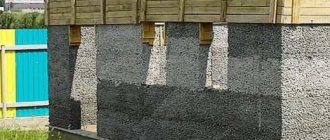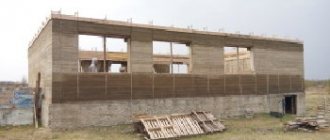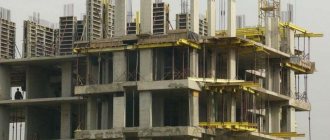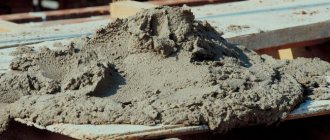Wood concrete, like ordinary concrete, allows for two main construction methods: block and monolithic. In the first case, fairly large blocks are used, which are laid out like bricks. In the second case, wood concrete is poured into formwork, like all other types of monolithic concrete.
Features of monolithic wood concrete
The technical characteristics of monolithic material are no different from block ones. Wood concrete is produced according to a similar scheme, with the exception of the stage of pouring into molds and hardening. This stage is implemented directly on the construction site.
Most often, monolithic wood concrete is used for the construction of houses, for example, consisting of two floors, as shown in the video below:
Advantages
The undoubted advantages of the material include the following properties:
- excellent thermal insulation qualities . Moreover, this applies to both structural and heat-insulating material - it is 5–7 times higher than that of clay brick;
- the material does not burn , despite the organic filler: firstly, cement ensures non-flammability, and secondly, the wood is specially treated with fire retardants;
- wood concrete is extremely easy to process : sawn, cut, drilled, holds fasteners well, so construction from it always takes the shortest possible time;
- the material is not susceptible to rotting and mold , but is attractive to rodents;
- low weight – walls and partitions made of wood concrete create a very low weight load. Accordingly, you can choose a lightweight foundation for the house;
- A very outstanding advantage is resistance to bending stress . The blocks regain their shape at 10% deformation under load. If foam concrete with the same density indicators reacts to foundation movements with cracks and destruction, then nothing similar happens with wood concrete.
Flaws
The disadvantages of wood concrete, both monolithic and block, are as follows:
- high water absorption - wood chips absorb water well and swell, so monolithic wood concrete can be used for construction only in cases where the air humidity in the room never exceeds 75%;
- wood concrete needs protection: according to GOST, the outer layer of products made from it must be treated with decorative concrete or cement-lime mortar. There may not be an inner layer. The material must be plastered;
- very good waterproofing of the foundation is required;
- in a building made of wood concrete, a roof with long overhangs is installed so that they protect the walls from rain and snow.
How to make it yourself
To make wood concrete you will need wood chips, cement, water, and mineral additives.
To prepare wood chips, you will need a special wood waste shredder - a shredder, and to mix the solution - a concrete mixer .
Advice
Machines can be rented.
There are many recipes for preparing wood concrete; when preparing the mixture, one of the most important conditions is preliminary drying and processing of wood chips . To prevent rotting and increase the fire resistance of the material, the chips are pre-treated with an antiseptic and fire retardant, then dried. Mineral additives are added to the solution or the wood chips are treated and then dried.
Composition and proportions of the mixture
These indicators depend on the purpose of the wood concrete (structural or thermal insulation), the desired grade of wood concrete, the moisture content of the wood chips, and the grade of cement:
- to prepare 1 m3 of structural wood concrete grade B 2.5, take 320 kg of M400 cement, 190 kg of filler and 330 liters of water;
- To prepare 1 m3 of thermal insulating wood concrete grade B 0.35, take 280 kg of cement, 1170 kg of wood chips and 300 liters of water.
Important!
There are no exact proportions of the mixture, since cement of the same brand from different manufacturers may differ, and wood chips do not have the same moisture content. Therefore, several control batches may be needed to determine the exact dosage of components.
Proportions of mineral supplement
wood chips
It is advisable to use wood chips from coniferous trees , with the exception of larch; it is possible to use wood chips from deciduous trees. According to GOST, chips should have a size of no more than 25×5×10 mm ; with a larger size, the strength characteristics of the material deteriorate; with a smaller size, the consumption of expensive cement increases and the thermal insulation qualities deteriorate.
Attention!
Raw materials must be free of rot, mold, foreign particles, and in winter - without snow or ice.
To neutralize sugars in wood, which negatively affect the quality of cement, the wood chips are dried in the sun for at least 3 months, constantly stirring (not in a heap!), or treated with chemical components.
Chemical components
The chemical components used (per 1 m3 of mixture) are technical calcium chloride - 8 kg, or sodium liquid glass - 8 kg, or a mixture of aluminum sulfate with quicklime - 20...25 kg.
When using lime, 1 m3 of wood chips is soaked in lime milk containing 2.2 kg of fluffed lime per 150-200 liters for 3-4 days with regular stirring, then squeezed out. Since this process is quite dangerous due to chemical burns, calcium chloride or liquid glass is more often used at the rate of 2-5% by weight of cement.
Proportions of components per 1 m3 of wood concrete
Composition adjustments
If during mixing they use cement of a lower or higher grade than the recommended M 400, or too wet chips, then correction factors are applied to the percentage of the components:
- Cement M 300 - coefficient 1.05;
- cement M500 - coefficient 0.96;
- cement M600 - coefficient 0.93;
- with chip moisture content of 20% - coefficient 1.2; in this case, the amount of water is reduced by its content in the wood.
To determine the exact amount of chemical additives, test batches are made : if, when introducing 5% additives, whitish streaks appear on the dried sample, the amount of the component can be reduced.
This video shows what failure to do in proportion can lead to:
Kneading process
To mix wood concrete concrete, you can use a tin tank or bath, but it is easier to mix the components in a mortar mixer . The prepared wood chips are mixed with dry cement and a mineral additive, then water is poured in and kneaded until smooth. The mixture should be moderately moist, but the solution should not drain.
The mixture is fed into the prepared formwork, poured in layers no more than 30 cm high , then compacted.
Kinds
Monolithic wood concrete, just like regular concrete, is available in two types.
- Structural - it corresponds to strength classes B1, B1.5, B2, B2.5, B3, B3.5. Their density ranges from 500 to 850 kg/cubic meter. m. This material can be used to construct load-bearing walls and partitions. But, since its strength is still low, the construction of only 1- and 2-story buildings is allowed.
- Thermal insulation - strength class B0.5, B0.75, density from 300 to 500 kg/cubic. m. Thermal insulating wood concrete is used to fill cavities and inter-wall voids.
The strength of wood concrete is determined by the brand of cement used. When this is not enough, and this happens often, reinforced wood concrete is used.
We will talk further about the types of frames for a monolithic house made of wood concrete, as well as the possibility of building without it.
What else should be taken into account when performing work
In conclusion, it is worth paying attention to a few more features of the material. They can significantly affect the speed of work during the construction process and the result at the end:
- since wood concrete elements differ in shape and size depending on their place in the structure, it is worth making sure that the formwork is assembled correctly before fixing it;
- when purchasing materials, you should pay attention to reviews of the manufacturer, by which you can determine the quality of the geometry, ease of installation and versatility of the blocks they produce;
- wood concrete may differ in the width of the voids present in it, but the larger the cavity, the more costs will be required for its reinforcement;
- Having decided on the dimensions and approximate weight of the building, when purchasing material you should pay attention to the possible maximum load on the element of the structure;
- the strength of blocks for a multi-storey building and a utility room is always different, so the right choice will allow you to rationally use the available funds;
- when choosing wood concrete, you should carefully check the accompanying documents for the content of additional substances in wood concrete;
- You should refuse to purchase if plasticizers containing phenol or naphthalene are found in the composition, since the use of such materials is a threat to the strength and safety of the home.
Permanent formwork made from wood concrete blocks is a material from which you can build a small but warm house. Its many advantages make it possible to use it both as the basis of a load-bearing wall and as an element of insulation. Provided you choose a quality material, install it correctly and waterproof it, you can get a structure that will delight its owner for many years.
Frame selection
Since the strength of wood concrete is not outstanding, only 1- and 2-story buildings are allowed to be built from it. However, with monolithic construction, it is quite possible to increase the strength of the building by constructing a frame.
- Wooden frame - for low-rise buildings, ordinary plank frames, which are installed vertically at a distance of 120–150 cm, are quite sufficient. Such an element is required for the opening - window and door. The boards not only increase the strength of the entire structure, but also serve as an expansion joint, allowing the load from shrinkage to be evenly distributed. Wood concrete is characterized by low shrinkage, but it still exists, and it is necessary to take this into account. A wooden frame is convenient because immediately after stripping, you can fasten rafters, beams, install window and door blocks, and so on. Moreover, with the monolithic method, it is not even recommended to compact wood concrete too much, since with a lower density the thermal insulation qualities increase.
Before use, boards must be treated with antiseptic agents.
- The metal frame is no less popular, as it seems much more reliable. Mesh and steel rods are used, as well as beams to create window lintels - this is a must. Metal must be protected from corrosion.
- Without a frame, only small buildings can be erected and in this case only wood concrete blocks are used.
A foundation cannot be built from monolithic wood concrete: the material absorbs moisture very well. Moreover, walls made of wood concrete are erected only on the base - at least 50 cm from the ground level.
According to reviews, monolithic construction of a house from wood concrete has its pros and cons, a reasonable price - we’ll talk about this later.
Application in construction
Since the material is light and does not create a large load, the foundation for any structures made of wood concrete is built of a lightweight type: pile, slab, unrecessed monolithic. Unlike its close “brother” - foam concrete, wood concrete reacts much weaker to foundation movements, as it has good tensile strength. So there is no need for a capital stable foundation here.
The main thing in wood-concrete construction is good protection from moisture. We’ll talk about formwork for monolithic wood concrete next.
The owner of such a building talks about the construction of a house and monolithic wood concrete:
We build buildings
Even when constructing a 1-story building, it is recommended to erect a frame. And in this case, the formwork is easier to secure, and the load in the walls is distributed evenly. Metal or wood - depends on the specifics of the project.
The principle of construction is no different from conventional concreting.
- The foundation is erected from monolithic heavy concrete. The base is 50 cm, can be built from clay bricks or precast concrete. Very good waterproofing is essential, otherwise the porous wall material will draw moisture from the foundation.
- They build a frame - wooden or metal.
- When constructing walls, two methods are used: with removable formwork and non-removable formwork.
Removable formwork
As removable formwork, ordinary plywood with a thickness of 25 mm, metal sheets or any boards with a thickness of at least 50 mm are used. Plywood absorbs moisture less and requires multiple uses, which cannot be said about boards.
The formwork is removed after achieving sufficient strength - 2–3 days at a temperature not lower than +18–+20 C, and 7 days if the temperature is lower.
Tooling and equipment
To fill the wood concrete, we first need formwork. Laminated technical waterproof plywood or moisture-resistant OSB-4 with a thickness of 14-16 mm is suitable for it.
The total length of the formwork should be at least enough to fill the longest wall of the house. And ideally for the entire or at least half of the perimeter of the house.
Ideally, there should be enough formwork to fill a row along the entire perimeter of the house.
For compaction, we will make or buy a manual tamper. Its heel should be square with a side length of 15-20 cm, and a total weight of 7-10 kg.
To mix the mixture, you will need a concrete mixer, or, of appropriate size, a container for manual mixing.
You can't do without scaffolding and ladders. A board made of a board 50 mm thick and 40 cm wide is enough so that a person can calmly stand on it and work as a tamper.
And, of course, you will need shovels, buckets for feeding the mixture into the formwork, a tape measure, construction squares, a construction bubble level and a hydraulic level or level.











